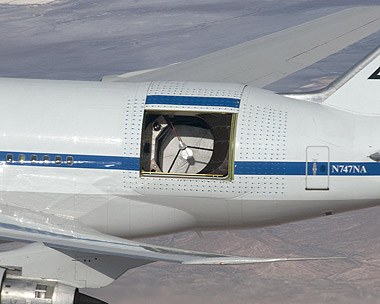News about SOFIA
SOFIA, the Stratospheric Observatory for Infrared Astronomy, flew for the first time since January 2008 on 9 December 2009. The extensively modified Boeing 747SP - carrying a 2.5-metre infrared telescope - made a three hour long test flight, primarily to test the in-flight performance of the aircraft and run system checks, but also to test the engines, control and communications systems. The modified passenger aircraft flew in a restricted area over the Mojave Desert near Edwards Air Force Base, where the NASA Dryden Flight Research Center is located.
Doors fully opened opened during flight
Video: NASA.
The second flight was made on 18 December 2009: the 'short body' jumbo jet flew once again for one hour 19 minutes. This time the door covering the telescope was fully opened during the flight and the telescope subjected for the first time to actual operational conditions. The engineers and scientists were investigating the nature of the airflow through and around the telescope. Bob Meyer, SOFIA programme manager at NASA's Dryden Flight Research Center, says: "Today we opened the telescope cavity door, the first time we have fully exposed the telescope and the largest cavity ever flown while in flight" and adds: "This is a significant step toward certification of this large observatory, which will be used by German and American astronomers to explore the secrets of the universe." In short, the test flight obviously was a significant milestone for the project.

The latest flight was made on 15 January 2010 - a six hour test flight which constituted the most severe challenge so far for the German team: a general test of the SOFIA telescope with all its components, in flight. Researchers from the German SOFIA Institute (DSI) at the University of Stuttgart followed the flight both on board and from the control centre. DSI provides scientific coordination of the project on behalf of DLR.
On the way to First Light
Result: the telescope was successfully configured in inertial mode - that is, independent of the aircraft’s orientation - and pointed successfully in a variety of directions. The optimised Vibration Isolation System (VIS) was also successfully tested in all operating modes. Alfred Krabbe, the Director of DSI, is delighted with the tests: "This is a huge success and also a big step towards the next objective, the scientific 'first light'."
Now we are looking forward to the next flight, on 27 January 2010. This flight will test the SOFIA’s behaviour in flight and the aerodynamic stresses on the telescope’s frame at a variety of altitudes.
The SOFIA project is a collaboration between DLR German Aerospace Centre and the National Aeronautics and Space Administration (NASA). It was initiated on behalf of DLR with funding from the German Federal Ministry of Economics and Technology (BMWi) and funds from the State of Baden-Württemberg and the University of Stuttgart. The scientific aspects of the project are handled on the German side by the German SOFIA Institute (DSI) at the University of Stuttgart, and on the American side by the Universities Space Research Association (USRA).
More Information:
Images & Video: NASA.
Tags:
